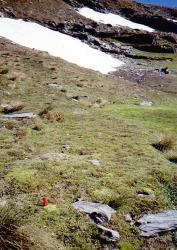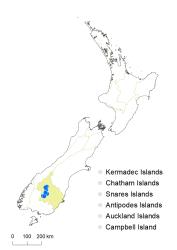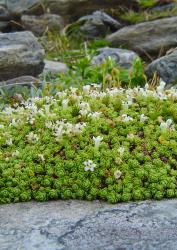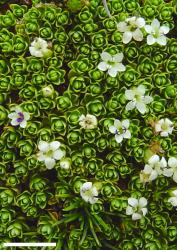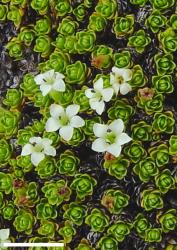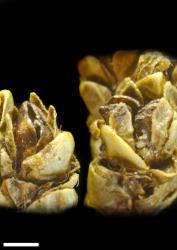- ≡ Veronica thomsonii var. glabra Cheeseman, Man. New Zealand Fl. 540 (1906)
- ≡ Chionohebe glabra (Cheeseman) Heads, Bot. Soc. Otago Newsl. 5: 4 (1987)
Low mat or cushion sub-shrub to 0.05 m tall. Stems decumbent to erect, glabrous. Leaf bud indistinct, its outer leaves fully grown, diverging. Leaves sub-decussate, erecto-patent to erect; lamina thin, oblanceolate to obovate, spathulate or rarely lanceolate to broadly ovate, 1.8–4.6 mm long, 0.7–2.3 mm wide, dull, medium to pale green in distal half, brownish to purplish near base; veins not evident; surfaces glabrous or with isolated trichomes distally or about middle; margin glabrous or very sparsely ciliate, entire; apex obtuse to sub-acute; base slightly narrowed; petiole absent. Inflorescence a solitary, axillary, bibracteate flower; flowers female or male on separate plants, ♂ > ♀; bracts opposite, narrowly lanceolate to ovate, rarely oblanceolate, or narrowly to very narrowly elliptic, ± equalling and investing calyx; pedicel absent. Calyx lobes 5, obtuse to sub-acute, 1.3–2.5 mm long, equal, glabrous or sparsely eglandular-ciliate, rarely a few hairs on upper abaxial surface. Corolla 1.5–4.1 mm diameter; tube white, 1.6–3.5 mm long, ≥ calyx, glabrous; lobes 5, white, erecto-patent to spreading, equal, narrowly to broadly ovate, 1–2 mm long, obtuse; nectar guides absent. Stamen filaments white, 0.16–0.90 mm long; anthers purple. Style glabrous, 2.6–5.5 mm long. Capsules angustiseptate, emarginate, glabrous, 1.9–2.5 mm long, 1.5–1.9 mm at widest point. Seeds ellipsoid, flattened, smooth, pale brown to brown, 0.5–0.8 mm long.
birleyi | spectabilis | trifida | densifolia | thomsonii | pulvinaris | chionohebe | ciliolata | |
|---|---|---|---|---|---|---|---|---|
Habit | lax sub-shrub | lax sub-shrub | lax sub-shrub | lax sub-shrub | cushion plant | cushion plant | cushion plant | cushion plant |
Stem hairs | eglandular & a few glandular, spreading | mixed glandular & eglandular, spreading | eglandular, retrorse | eglandular, retrorse | glabrous | glabrous | glabrous | glabrous |
Leaf size (mm) | 4.0–12 × 2.5–11 | 4.5–13 × 2.5–6.0 | 2–10 × 1–7 | 2–6.5 × 0.7–3 | 1.7–4.7 × 0.7–2.6 | 1.8–4.8 × 0.5–2 | 1.75–5 × 0.75–2.25 | 1.75–4.5 × 0.8–2.8 |
Leaf margins | deeply crenate to lobed | deeply crenate to lobed | shallowly toothed to lobed, rarely entire | usually entire, rarely 1–2 teeth or lobes | entire | entire | entire | entire |
Lamina | subcoriaceous, flat; margin not thickened, smooth | subcoriaceous, flat; margin not thickened, smooth | subcoriaceous, flat; margin not thickened, smooth | coriaceous, keeled, with thickened papillate margin | thin, flat; margin not thickened, smooth | thin, flat; margin not thickened, smooth | thin, flat; margin not thickened, smooth | thin, flat; margin not thickened, smooth |
Leaf hairs: adaxial | scattered eglandular | mixed eglandular & glandular | glabrous | glabrous | eglandular: in broad band across middle, occasionally scattered distally | eglandular appressed: scattered or in a central patch on distal half | absent | absent or isolated and scattered in distal ½ |
Leaf hairs: abaxial | scattered eglandular | mixed eglandular & glandular | glabrous | glabrous | glabrous, or stiff, eglandular, isolated distal hairs | glabrous or eglandular appressed scattered distally | absent or isolated in distal ½ | absent or isolated and scattered in distal ½ |
Leaf hairs: margin | eglandular-ciliate | mixed eglandular & glandular-ciliate | long glandular-ciliate | stiff eglandular-ciliate | ciliate in basal ⅔ with apical tuft | eglandular appressed: ciliate | absent or scattered cilia | ciliate throughout or in basal or distal half, usually with apical tuft |
Sexual system | cosexual | cosexual | cosexual | cosexual | dioecious | dioecious | dioecious | dioecious |
Inflorescence | 2–3 flowers, sometimes solitary bibracteolate | 2–3 flowers, sometimes solitary bibracteolate | 2–3 flowers, sometimes solitary bibracteolate | solitary bibracteolate | solitary bibracteolate | solitary bibracteolate | solitary bibracteolate | solitary bibracteolate |
Peduncle (mm) | 2–4 | 5–15 | 2–10 | 0 | 0 | 0 | 0 | 0 |
Pedicel (mm) | 0.3–1.5 | 2.5–5 | 0.5–7 | 0 | 0 | 0 | 0 | 0 |
Calyx lobes | 4 | 4 | 4 | 5 | 5 | 5 | 5 | 5 |
Corolla lobes | (4–)5(–6) | 4(–5) | 5(–6) | 5(–6) | 5 | 5 | 5 | 5 |
Corolla diameter (mm) | 7–10 | 18–25 | 15–20 | 7–16 | 2.5–5 | 2.5–6 | 1.5–4.1 | 2.1–6.5 |
Corolla shape | funnelform | funnelform | funnelform | funnelform | rotate | rotate | rotate | rotate |
Capsule size (mm) | 3–4 × 3–4 | 4–5 × 4–5 | 4.5–6 × 2.5–3 | 2.7–5 × 1.7–4.25 | 1.5–3 × 1–2 | 1–3 × 1.2–2.7 | 1.9–2.5 × 1.5–1.9 | 2.5–3.5 × 1.4–3.1 |
Capsule hairs | glabrous | mixed glandular & eglandular-hairy at apex | glandular-ciliate, sometimes glabrous | glabrous | glabrous to densely hairy at apex | eglandular-hairy, especially at apex | absent | absent or apical |
South Island: Otago (Pisa Range, Carrick Range, Old Woman Range, northern Old Man Range, Garvie Mountains).
Cushion herb-field and fell-field, damp sheltered sites in gullies and slopes often downhill from summer snow-banks in melt-water, in stony seepages and hollows. Recorded elevations range from 1360 to 1890 m.
V. chionohebe × trifida (see under V. trifida).
V. chionohebe × thomsonii. V. chionohebe and V. thomsonii grow together in the Garvie Mountains and Pisa Range, and it is possible that hybridisation occurs between them. This might be the reason that molecular systematics techniques have so far not provided evidence of genetic divergence between them, despite morphological and habitat differences (Meudt 2008; Meudt & Bayly 2008).
Flowers: January–March (sometimes December); fruits: March and probably later.
2n = 42 (Hair 1970, as “P[ygmea] thomsonii var. glabra”).
Veronica chionohebe is classified in V. subg. Pseudoveronica sect. Hebe and informally in the “snow hebe” group (Albach & Meudt 2010).
V. chionohebe is closely related to V. thomsonii although clearly recognisable by its morphology and habitat. Meudt (2008) and Meudt and Bayly (2008, as Chionohebe glabra) discussed its species status in relation to its possible derivation as an ecotype of V. thomsonii and the extent of gene flow between them through hybridisation.
Male plants have larger corollas than female plants do, and large, dark-coloured anthers.



